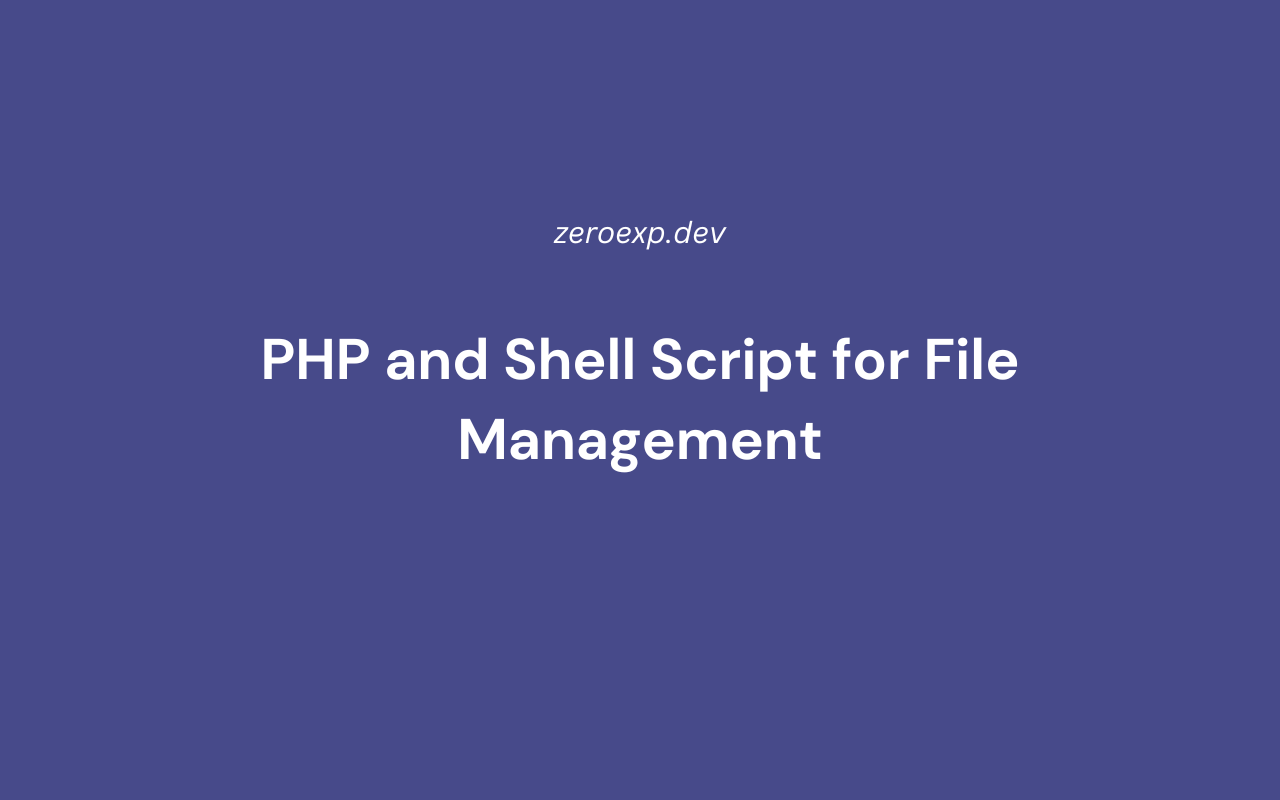Learn how to manage files in PHP using shell scripts. Automate copying, moving, renaming, and deleting files securely with PHP and Bash commands.
Introduction
Managing files on a server is a fundamental task in web applications, automation scripts, and system administration. PHP can execute shell scripts to handle copying, moving, renaming, and deleting files efficiently.
With PHP and Bash, you can:
- Copy and move files dynamically using PHP scripts
- Delete and rename files securely
- Manage large file operations using shell commands
- Automate file transfers and cleanup tasks
This guide covers:
- Running Bash commands from PHP for file management
- Copying, moving, and deleting files securely
- Handling file permissions and ownership issues
- Automating file cleanup using cron jobs
1. Copying Files Using PHP and Shell Scripts
Using shell_exec() to Copy a File
$file = '/var/www/html/sample.txt';
$destination = '/var/www/html/backup/sample_backup.txt';
shell_exec("cp $file $destination");
echo "File copied successfully.";
Using exec() for Structured Output
$output = [];
$returnVar = 0;
exec("cp $file $destination", $output, $returnVar);
if ($returnVar === 0) {
echo "File copied successfully.";
} else {
echo "Error copying file.";
}
Using a Bash Script to Copy Multiple Files
PHP Code to Trigger the Bash Script
shell_exec("bash /scripts/copy_files.sh /var/www/html /var/www/backup");
echo "Copy process started.";
copy_files.sh (Bash Script to Copy Files)
#!/bin/bash
SOURCE=$1
DESTINATION=$2
cp -r $SOURCE/* $DESTINATION/
echo "Files copied from $SOURCE to $DESTINATION"
2. Moving and Renaming Files with PHP and Bash
Using PHP to Move a File
$file = '/var/www/html/sample.txt';
$newLocation = '/var/www/html/archive/sample.txt';
shell_exec("mv $file $newLocation");
echo "File moved successfully.";
Using a Bash Script to Move Files
PHP Code to Execute Bash Script
shell_exec("bash /scripts/move_files.sh /var/www/html/temp /var/www/html/archive");
echo "Files moved.";
move_files.sh (Bash Script to Move Files)
#!/bin/bash
SOURCE=$1
DESTINATION=$2
mv $SOURCE/* $DESTINATION/
echo "Files moved from $SOURCE to $DESTINATION"
Renaming a File Using PHP and Shell Script
$file = '/var/www/html/sample.txt';
$newName = '/var/www/html/sample_renamed.txt';
shell_exec("mv $file $newName");
echo "File renamed successfully.";
3. Deleting Files and Directories Securely in PHP
Deleting a File Using PHP and shell_exec()
$file = '/var/www/html/delete_me.txt';
if (file_exists($file)) {
shell_exec("rm $file");
echo "File deleted successfully.";
} else {
echo "File not found.";
}
Deleting a Directory and Its Contents
$directory = '/var/www/html/old_logs';
shell_exec("rm -rf $directory");
echo "Directory deleted.";
Using a Bash Script to Delete Old Files
PHP Code to Run the Bash Script
shell_exec("bash /scripts/delete_old_files.sh /var/logs 30");
echo "Old files cleanup initiated.";
delete_old_files.sh (Bash Script to Remove Files Older Than X Days)
#!/bin/bash
DIRECTORY=$1
DAYS=$2
find $DIRECTORY -type f -mtime +$DAYS -delete
echo "Deleted files older than $DAYS days from $DIRECTORY"
Why Use This?
- Removes old log files or temporary data
- Automates server cleanup
4. Checking File Existence and Permissions in PHP
Check if a File Exists Before Performing Actions
$file = '/var/www/html/sample.txt';
if (file_exists($file)) {
echo "File exists.";
} else {
echo "File does not exist.";
}
Checking File Permissions Before Execution
$file = '/var/www/html/sample.txt';
if (is_writable($file)) {
echo "File is writable.";
} else {
echo "File is not writable.";
}
Modifying File Permissions Using PHP and Bash
$file = '/var/www/html/protected.txt';
shell_exec("chmod 644 $file");
echo "File permissions updated.";
5. Automating File Management with Cron Jobs
Scheduling a Script to Delete Old Files Automatically
To delete log files older than 7 days, create a cron job:
crontab -e
Add the following line:
0 3 * * * bash /scripts/delete_old_files.sh /var/logs 7
This executes the cleanup script every day at 3 AM.
6. Securely Running Shell Commands in PHP
Escaping User Input to Prevent Command Injection
Unsafe Code (DO NOT USE)
$filename = $_GET['file'];
shell_exec("rm $filename"); // Dangerous
Safe Code (Using escapeshellarg())
$filename = escapeshellarg($_GET['file']);
shell_exec("rm $filename");
Restricting PHP Script Execution with sudoers
To allow PHP to run privileged shell commands, add a rule in sudoers:
sudo visudo
Add the following:
www-data ALL=(ALL) NOPASSWD: /path/to/script.sh
Then, execute in PHP:
$output = shell_exec('sudo bash /path/to/script.sh');
echo "<pre>$output</pre>";
Best Practices for File Management Using PHP and Shell Scripts
- Use Bash scripts for bulk operations
- Escape user inputs to prevent security risks
- Set proper permissions when handling sensitive files
- Use cron jobs for scheduled file management
- Test scripts in a development environment before deploying
Conclusion
PHP and shell scripts provide efficient file management for copying, moving, renaming, and deleting files on a server.
This guide covered:
- Executing shell commands for file operations
- Using Bash scripts to manage files dynamically
- Automating file cleanup with scheduled tasks
- Implementing security measures when executing shell commands
By integrating PHP with shell scripting, file management tasks can be automated and optimized efficiently.
